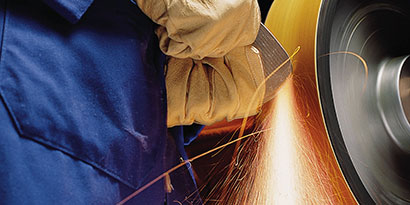Today we start to look into finishing.
The number one rule is to start at the desired finish.
If the customer wants 4B finish, which is 120-150 grit, why not start by cutting the weld with a 120 flap wheel. Is it going to be slower, yes, but if you can do it in only one step then it is a big win for time, material used and the quality of the finish. What happens if the 120 did not work, then you go three steps courser to a 60 grit and follow that with the 120 grit, making it a two-step procedure.
Here are the grits,
12, 16, 24, 30, 40, 50, 60, 80, 100, 120, 150, 180, 220, 240, 320, 360, 400, 500, 600, 800, 1000
When looking into the finishing needs for our customers, one of the first questions we should ask is “What is the standard called for in their contract?” Most contracts will have a “B” finish or an RA number. Both of these signifiers mean the same thing. A typical response from the customer when you ask the question of what finish they are trying to achieve might be 4B or a 34 finish. So what does this mean to the sales reps in trying to meet this challenge?
What is the meaning of RA, and why is it important? RA stands for roughness average. It is the average depth of the scratch on the surface of the substrate. The minimum established RA’s are very important to achieve as they affect the safety of the public as well as the aesthetics of the substrate. In the case of food safety, the minimum RA established is 40, so any contracts that call for food processing must achieve a finish of 25-40. This is mandated so that the cleaners used in these machines will be able to get out the bacteria in those depth of scratches.
Some contracts call for “B” finished, which are just ranges of RA number.
“2B” finish is greater than a 60 RA
“3B” finish is 50-60 RA
“4B” sanitary finish is 25-40 RA
“4B” pharmaceutical finish is 12-16 RA
“7B” finish is a 4-8 RA
“8B” finish is a 1-4 RA (mirror finish)
Today we are discussing how to achieve the two most common finishes requested by our customers, a number 4B sanitary finish and a number 8B mirror finish.
How to achieve a 4B Sanitary Finish
First you need to determine if it is a MIG weld or a TIP weld
For MIG weld applications we would start with a 60 grit flap disc, followed by a 120 flap disc
For a TIG weld we would just use a 120 grit flap disc
It is important that to remember that you must leave enough weld on the surface to facilitate the next steps. A general rule is to leave enough to catch your thumb nail.
It is also important for the next steps that we have a variable speed polisher
After we have cut down the weld, the next step is to use a medium scotch brite pad at 4,000 RPM
If done correctly this should give you a 4B finish
If desired by the customer, you can give it a brushed finish by using a Blendex 2 and 1 roll at 2.000 RPM.
How to achieve an 8B Mirror Finish
Using the two steps above, we add a fine scotch brite at 4,000 RPM and follow that with a felt polishing pad with white polishing paste on it, run at 2,000 RPM
Our final step is to clean the surface using a new felt pad, apply blue polishing paste and run at 2,000 RPM
This procedure should give you a perfect mirror finish.
BY: Craig Cooley Abrasive Specialist



